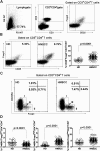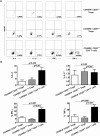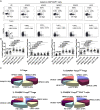CD45RA-Foxp3high but not CD45RA+Foxp3low suppressive T regulatory cells increased in the peripheral circulation of patients with head and neck squamous cell carcinoma and correlated with tumor progression
- PMID: 24761979
- PMCID: PMC4022051
- DOI: 10.1186/1756-9966-33-35
CD45RA-Foxp3high but not CD45RA+Foxp3low suppressive T regulatory cells increased in the peripheral circulation of patients with head and neck squamous cell carcinoma and correlated with tumor progression
Abstract
Background: T regulatory cells (Tregs) contribute to the progression of head and neck squamous cell carcinoma (HNSCC) by suppressing antitumor immunity. However, little is known regarding the functional heterogeneity of Tregs in HNSCC patients.
Methods: Using multicolor flow cytometry, the frequency of three Treg subsets, separated on the basis of CD45RA and Foxp3, from the peripheral circulation of newly-presenting HNSCC patients (19 oral cavity squamous cell carcinoma, 20 hypopharyngeal squamous cell carcinoma, 18 nasopharyngeal squamous cell carcinoma, 19 oropharyngeal squamous cell carcinoma, and 36 laryngeal squamous cell carcinoma) were assessed with regard to 31 healthy donors and clinicopathological features. Moreover, the functional capacity of each Treg subsets was evaluated based on CD45RA and CD25 expression.
Results: The frequency of Tregs in the peripheral circulation of HNSCC patients as a whole cohort was higher than in healthy donors (P < 0.0001). However, the frequency of Tregs was similar between patients with oral cavity squamous cell carcinoma and healthy donors (P = 0.269). Further dividing Tregs into three subsets based on Foxp3 and CD45RA expression revealed that the frequency of CD45RA-Foxp3high Tregs and CD45RA-Foxp3lowCD4+ T cells in patients with HNSCC developing from different subsites was higher than in healthy donors (P < 0.0001, P < 0.0001), whereas the frequency of CD45RA+Foxp3low Tregs was lower than in healthy donors (P < 0.0001). Functionally study revealed that CD45RA-CD25+++ Tregs significantly inhibit the proliferation of CD4+CD25- T cells (P < 0.001) and secrete lower levels of cytokines (P < 0.01) compared with CD45RA-CD25++CD4+ T cells. Importantly, the frequency of CD45RA-Foxp3high Tregs positively correlate with tumor stage (P < 0.0001) and nodal status (P < 0.0001).
Conclusions: CD45RA-Foxp3high Tregs increase in the peripheral circulation of HNSCC patients, and correlate with tumor stage and nodal status; suggesting a role in tumor progression which may be manipulated by future immunotherapy.
Figures




Similar articles
-
Increased frequency and suppressive activity of CD127(low/-) regulatory T cells in the peripheral circulation of patients with head and neck squamous cell carcinoma are associated with advanced stage and nodal involvement.Immunology. 2013 Nov;140(3):335-43. doi: 10.1111/imm.12144. Immunology. 2013. PMID: 23826668 Free PMC article.
-
Functionally distinct subsets of CD4⁺ regulatory T cells in patients with laryngeal squamous cell carcinoma are indicative of immune deregulation and disease progression.Oncol Rep. 2015 Jan;33(1):354-62. doi: 10.3892/or.2014.3553. Epub 2014 Oct 20. Oncol Rep. 2015. PMID: 25333227
-
CD45RA-Foxp3high regulatory T cells have a negative impact on the clinical outcome of head and neck squamous cell carcinoma.Cancer Immunol Immunother. 2017 Oct;66(10):1275-1285. doi: 10.1007/s00262-017-2021-z. Epub 2017 May 27. Cancer Immunol Immunother. 2017. PMID: 28551813 Free PMC article.
-
Tumor-infiltrating ICOS+ Effector Regulatory T-Cells in Oral Squamous Cell Carcinoma as a Promising Biomarker for Prognosis and 'Hot' Tumor.Anticancer Res. 2022 May;42(5):2383-2393. doi: 10.21873/anticanres.15717. Anticancer Res. 2022. PMID: 35489733 Review.
-
Metabolic targeting of regulatory T cells in oral squamous cell carcinoma: new horizons in immunotherapy.Mol Cancer. 2024 Dec 19;23(1):273. doi: 10.1186/s12943-024-02193-7. Mol Cancer. 2024. PMID: 39696340 Free PMC article. Review.
Cited by
-
Blockade of MCP-1/CCR4 signaling-induced recruitment of activated regulatory cells evokes an antitumor immune response in head and neck squamous cell carcinoma.Oncotarget. 2016 Jun 21;7(25):37714-37727. doi: 10.18632/oncotarget.9265. Oncotarget. 2016. PMID: 27177223 Free PMC article.
-
Cuproptosis-related LncRNAs are correlated with immunity and predict prognosis in HNSC independent of TMB.Front Genet. 2023 Feb 1;14:1028044. doi: 10.3389/fgene.2023.1028044. eCollection 2023. Front Genet. 2023. PMID: 36816017 Free PMC article.
-
The emerging role of immunotherapy in head and neck squamous cell carcinoma (HNSCC): anti-tumor immunity and clinical applications.Ann Transl Med. 2016 May;4(9):173. doi: 10.21037/atm.2016.03.34. Ann Transl Med. 2016. PMID: 27275486 Free PMC article. Review.
-
Functional and Phenotypic Plasticity of CD4(+) T Cell Subsets.Biomed Res Int. 2015;2015:521957. doi: 10.1155/2015/521957. Epub 2015 Oct 25. Biomed Res Int. 2015. PMID: 26583116 Free PMC article. Review.
-
Eliciting cytotoxic T lymphocytes against human laryngeal cancer-derived antigens: evaluation of dendritic cells pulsed with a heat-treated tumor lysate and other antigen-loading strategies for dendritic-cell-based vaccination.J Exp Clin Cancer Res. 2016 Jan 22;35:18. doi: 10.1186/s13046-016-0295-1. J Exp Clin Cancer Res. 2016. PMID: 26795730 Free PMC article.
References
Publication types
MeSH terms
Substances
LinkOut - more resources
Full Text Sources
Other Literature Sources
Medical
Research Materials

